Subscriber Exclusive
Durham Chevrons Cowl
The incised chevron columns at Durham Cathedral inspired Kate to design a textile that translated stone into fiber.
The incised chevron columns at Durham Cathedral inspired Kate to design a textile that translated stone into fiber. <a href="https://spinoffmagazine.com/durham-chevrons-cowl/">Continue reading.</a>
https://spinoffmagazine.com/cdn-cgi/image/format=auto/https://www.datocms-assets.com/75073/1656685410-durham-chevrons-1.jpg?auto=format&w=900
Chevron and zigzag patterns are not just knitters’ motifs. They have been reinterpreted by artists, both ancient and modern, time and again in many mediums. Whether on pottery, in architecture, or embroidered on cloth, these symbols are common to many different cultures around the world. The famous chevron columns of Durham Cathedral in the north of England inspired this cowl, which is knitted as a tube with alternating colors and a bit of texture.
Designing a yarn to meet a grand plan is one of my favorite aspects of handspinning. I choose not only the color of the yarn to create a piece but also its texture, drape, and character. For this project, I designed a cowl with undulating stripes made with two yarns, one airy and sheer and one a bit denser to give the piece shape.
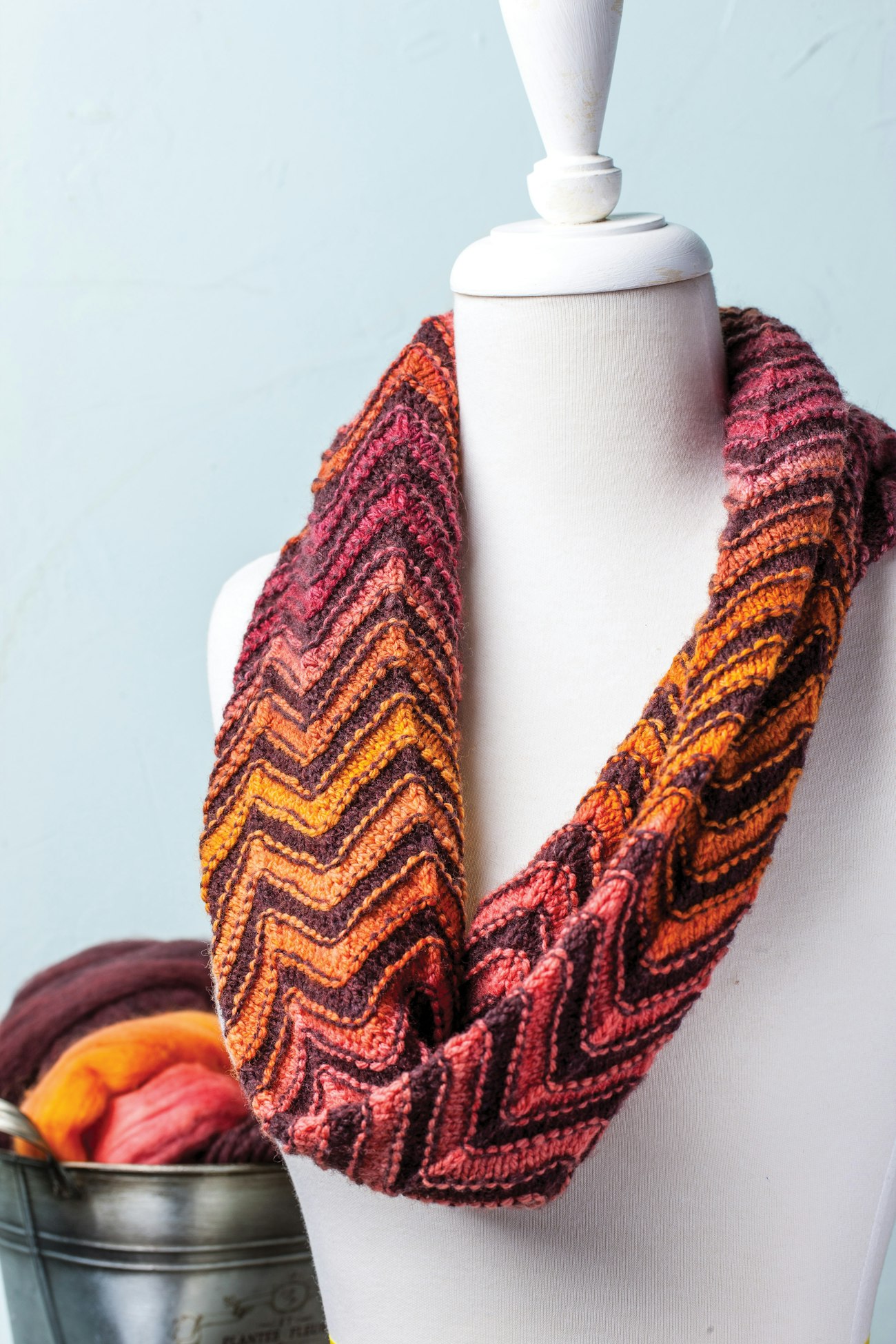
This was a great opportunity to use a worsted-spun, chain-plied yarn to create a gradient effect. Chain plying, also called Navajo plying, allowed me to keep colors distinct when spinning painted combed top and created a round, three-ply yarn. The contrasting roving is spun into a two-ply, woolen-spun yarn that is airy and supple—almost acting as a shadow to the gradient three-ply. Using two different spinning and plying techniques produced two different textures within the same project.
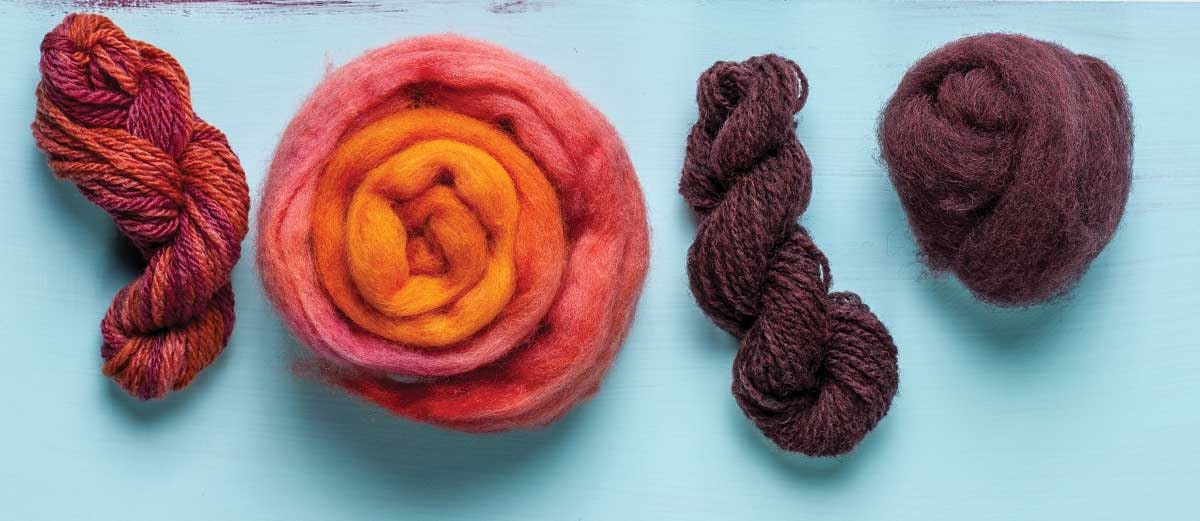
Spinning
For the main color I used a dreamy Polwarth/silk handpainted combed top dyed by Copper Corgi Fiber Studio, which I spun with a worsted draw. I didn’t split the combed top into smaller strips for spinning because I wanted long color progressions. I chain-plied my handspun singles into a medium-twist, bouncy worsted-weight knitting yarn.
For the contrasting color I used Corriedale roving dyed with cochineal and madder to spin an airy yarn using a woolen draw. The resulting two-ply, sportweight yarn is a finer gauge than the main color, but it has a slightly fuzzy halo and matte appearance.
Log in to see the project instructions. This project was published in the Fall 2015 issue of Spin Off —Editor
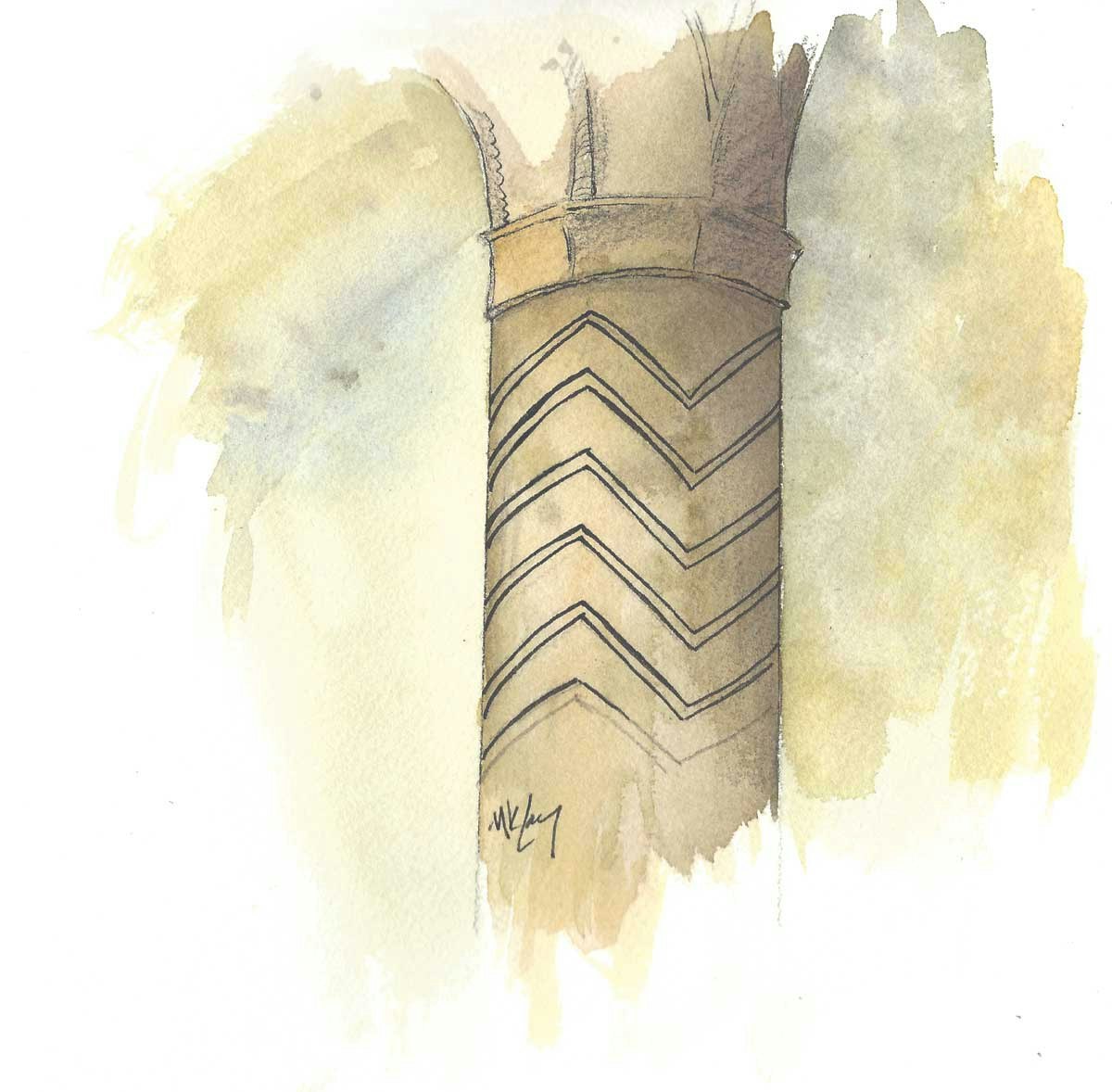
Kate wanted to catch the columns’ texture, which is both static and rhythmic, creating a balance of light and shade. Watercolor by Kate Larson
Cowl
- Fiber MC: handpainted Polwarth/silk top, 4 oz; CC: 100% solid-colored Corriedale roving, 4 oz. Shown here: MC: Copper Corgi Fiber Studio Polwarth/silk top in orange/red; CC: Handspun by Stefania 100% Corriedale roving dyed with cochineal and madder.
- Yarn MC: 3-ply; 215 yd; 900 ypp; 10 wpi; worsted weight. CC: 2-ply; 215 yd; 1,525 ypp; 11 wpi; sportweight.
- Needles U.S. size 6 (4 mm): 16" circular (cir); second cir in same size or smaller to hold sts while grafting. Adjust needle size if necessary to obtain the correct gauge.
- Gauge 28 sts and 25 rnds = 4" in chevron patt. Note: A variety of gauges will work for this project. Changing gauge will also change the yardage required and finished size.
- Notions Smooth waste yarn for provisional CO; markers (m); tapestry needle.
- Finished Size 38" circumference and 71⁄4" wide (doubled in tube shape).
See spinoffmagazine.com for terms you don’t know.
SUBSCRIBER EXCLUSIVE
Chevron and zigzag patterns are not just knitters’ motifs. They have been reinterpreted by artists, both ancient and modern, time and again in many mediums. Whether on pottery, in architecture, or embroidered on cloth, these symbols are common to many different cultures around the world. The famous chevron columns of Durham Cathedral in the north of England inspired this cowl, which is knitted as a tube with alternating colors and a bit of texture.
Designing a yarn to meet a grand plan is one of my favorite aspects of handspinning. I choose not only the color of the yarn to create a piece but also its texture, drape, and character. For this project, I designed a cowl with undulating stripes made with two yarns, one airy and sheer and one a bit denser to give the piece shape.

This was a great opportunity to use a worsted-spun, chain-plied yarn to create a gradient effect. Chain plying, also called Navajo plying, allowed me to keep colors distinct when spinning painted combed top and created a round, three-ply yarn. The contrasting roving is spun into a two-ply, woolen-spun yarn that is airy and supple—almost acting as a shadow to the gradient three-ply. Using two different spinning and plying techniques produced two different textures within the same project.

Spinning
For the main color I used a dreamy Polwarth/silk handpainted combed top dyed by Copper Corgi Fiber Studio, which I spun with a worsted draw. I didn’t split the combed top into smaller strips for spinning because I wanted long color progressions. I chain-plied my handspun singles into a medium-twist, bouncy worsted-weight knitting yarn.
For the contrasting color I used Corriedale roving dyed with cochineal and madder to spin an airy yarn using a woolen draw. The resulting two-ply, sportweight yarn is a finer gauge than the main color, but it has a slightly fuzzy halo and matte appearance.
Log in to see the project instructions. This project was published in the Fall 2015 issue of Spin Off —Editor

Kate wanted to catch the columns’ texture, which is both static and rhythmic, creating a balance of light and shade. Watercolor by Kate Larson
Cowl
- Fiber MC: handpainted Polwarth/silk top, 4 oz; CC: 100% solid-colored Corriedale roving, 4 oz. Shown here: MC: Copper Corgi Fiber Studio Polwarth/silk top in orange/red; CC: Handspun by Stefania 100% Corriedale roving dyed with cochineal and madder.
- Yarn MC: 3-ply; 215 yd; 900 ypp; 10 wpi; worsted weight. CC: 2-ply; 215 yd; 1,525 ypp; 11 wpi; sportweight.
- Needles U.S. size 6 (4 mm): 16" circular (cir); second cir in same size or smaller to hold sts while grafting. Adjust needle size if necessary to obtain the correct gauge.
- Gauge 28 sts and 25 rnds = 4" in chevron patt. Note: A variety of gauges will work for this project. Changing gauge will also change the yardage required and finished size.
- Notions Smooth waste yarn for provisional CO; markers (m); tapestry needle.
- Finished Size 38" circumference and 71⁄4" wide (doubled in tube shape).
See spinoffmagazine.com for terms you don’t know.
[PAYWALL]
Stitch Guide
S2kp2: Sl 2 sts as if to k2tog, k1, pass 2 sl sts over—2 sts dec’d.
Durham Chevrons Pattern: (multiple of 20 sts)
Rnd 1 Purl.
Rnd 2 K1f&b, k8, s2kp2, k7, k1f&b; rep from * to end.
*Rnd 3 Knit.
Rnd 4 Rep Rnd 2.
Rep Rnds 1–4 for patt.
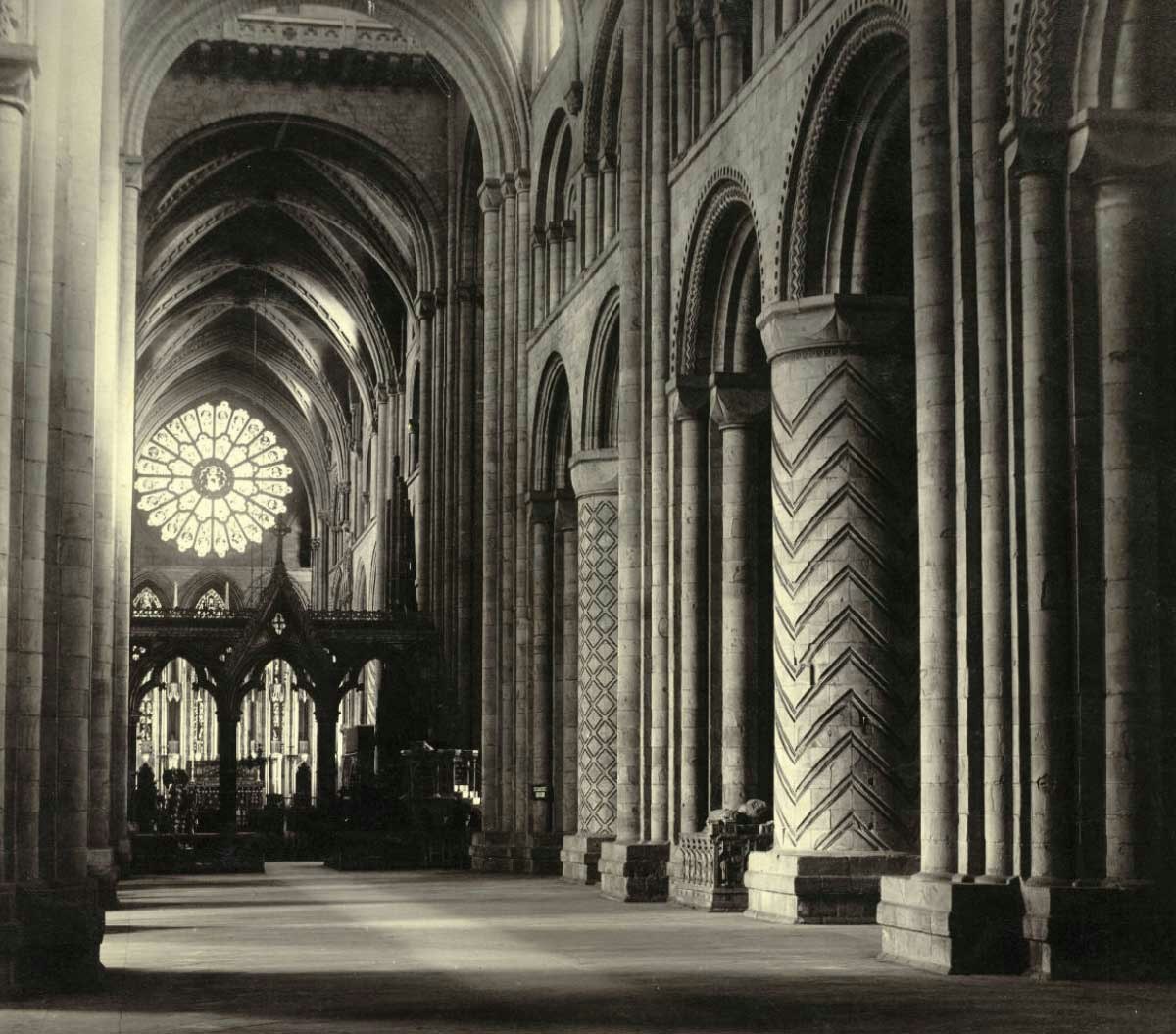
The incised chevron columns at Durham Cathedral inspired Kate to design a textile that translated stone into fiber. Photo courtesy of A. D. White Architectural Photographs, Cornell University Library
Notes
- This cowl is worked in the round as a tube on a circular needle. The beginning and end of the tube are grafted together using Kitchener stitch after the piece is completed. This means that only the right side of the fabric shows, making selvedges unnecessary and hiding the wrong side of the work. This creates a stretchy, easy-to-wear accessory.
- Working yarns can be carried loosely from one stripe to the next, eliminating the need to weave in ends. If the new color is always brought over the top of the last color used when changing colors, they twist on the next color change and eliminate a color “jog.” Keep these transitions loose to reduce puckering.
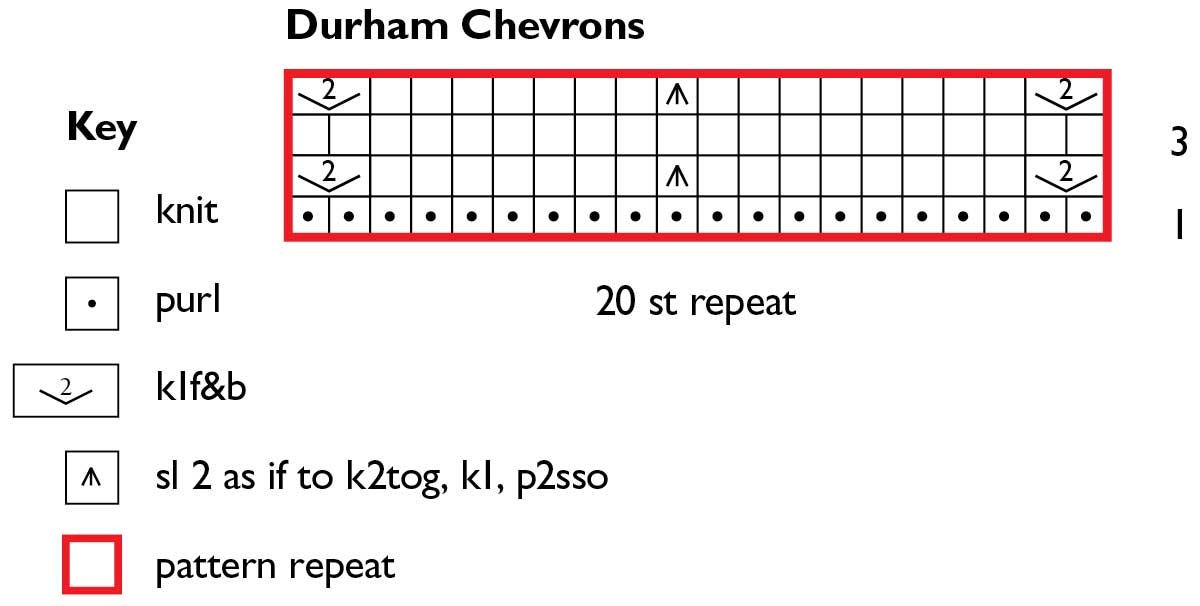
Cowl
With cir needle, CC, and using a provisional method, CO 100 sts. Place marker (pm) and join in the rnd.
Rnds 1–4 With MC, work Durham Chevrons patt (see Stitch Guide) or chart.
Rnds 5–8 With CC, work Durham Chevrons patt or chart.
Rep Rnds 1–8 until piece measures about 38" from CO, or desired length, ending with Rnd 6. Leave sts on cir needle.
Finishing
Weave in ends. Remove waste yarn from provisional CO, placing live sts onto extra cir needle.
Beg at end of rnd at both CO and BO ends and making sure work is not twisted, graft ends tog using Kitchener st. Soak in warm water and roll in a towel to remove excess water. Lay on a surface to dry in a ring (rather than shaped flat) to give your cowl a rounder, more natural look.
Resources
Kate Larson loves to explore the many ways in which textiles connect people and environments near and far. When she isn’t traveling or teaching, she can be found in the barn with her flock of Border Leicesters. Find her at katelarsontextiles.com.






